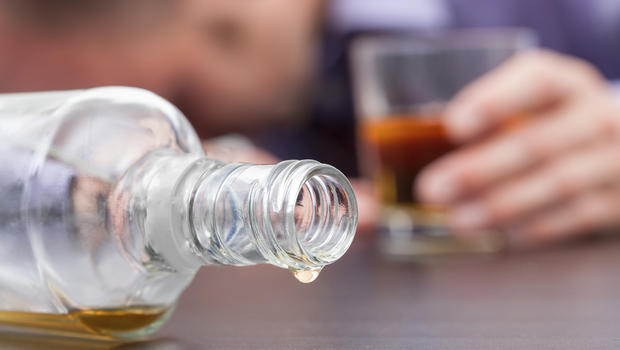
By the end of the day, an estimated six Americans will have died from alcohol poisoning, but it’s a “surprising group” that’s dying at higher rates than any other, according to a new report from the Centers for Disease Control and Prevention.
That adds up to an average of 2,221 people in the United States — a conservative estimate, according to the CDC — dying annually, making it one of the leading preventable causes of death. The numbers come from death certificate data collected from 2010 to 2012. Interestingly, the report shows that the majority (more than 75 percent) of alcohol poisoning deaths happen in adults between the ages of 35 and 64, revealing that binge drinking is not a behavior solely observed among young people.
“The majority of these deaths are not among college students, whom we typically associate with binge drinking,” lead author Ileana Arias, principal deputy director for the CDC, said in a teleconference Tuesday. “We were surprised.”
Those most at risk, according to the data, are middle-aged white males. More than 75 percent of people who die from alcohol poisoning deaths are men, and nearly 70 percent are white people, the agency found. However, while the greatest number of deaths overall occurred among whites, the highest fatality rate (measured as the number of deaths per million) was observed among American Indians and Alaska Natives. That’s in line with other recent research: A study published in June 2014 found that American Indians/Alaska Natives are seven times more likely to die from alcohol poisoning than whites.

There were also wide state-to-state variations. For example, Alaska had the highest rate of alcohol poisoning deaths, with 46.5 deaths per million residents, while Alabama had the lowest fatality rate at 5.3 per million residents. Among the 10 states with the highest average annual number of alcohol poisoning deaths, eight are in the West: Alaska (46.5), New Mexico (32.7), Arizona (18.7), Wyoming (17.7), South Dakota (17.0), Utah (16.7), Colorado (14.4) and Oregon (12.7), the CDC found.

The dangers of binge drinking
The new report analyzed deaths from alcohol poisoning among people 15 and older, using death certificates from the National Vital Statistics System from 2010 to 2012. Alcohol dependence, or alcoholism, was identified as a contributing factor in just 30 percent of deaths from alcohol poisoning. Other drugs were noted to have been a factor in only about 3 percent of deaths, and hypothermia – or abnormally low body temperature – was listed as a contributing cause of death in 6 percent of cases.
Alcohol poisoning happens when a person consumes a toxic amount of alcohol, usually in the context of binge drinking. “[T]here is a hand and glove relationship between alcohol poisoning death and binge drinking,” said Dr. Bob Brewer, the study’s co-author. “The risk of death from alcohol poisoning goes up significantly with the amount that people consume [per episode].”

Typically, “binge drinking” for men involves consuming five or more alcoholic beverages in two to three hours, according to the CDC (see the chart above for the definition of a “standard drink”). For women, it’s drinking four or more in that same period. However, earlier research shows most of the 38 million or more Americans who admit to binge drinking say they actually drink about eight drinks in two to three hours and they do this on average four times per month.
If too much alcohol is consumed in a short period of time, the liver can’t keep up with its job of filtering alcohol out of your blood. What the liver can’t filter out backs up into your bloodstream. When this happens, the blood alcohol concentration in your bloodstream can become too high, which eventually causes the body to shut down areas of the brain that control breathing, heart rate and body temperature – leading to a coma or even death. Signs that someone may be suffering potentially fatal alcohol poisoning include severely slurred speech, loss of coordination, slow or irregular breathing, hypothermia (low body temperature), seizures, and vomiting.

A person’s response to alcohol can vary depending on many factors, including the amount and rate of alcohol consumed, the health of the drinker, and whether the drinker has consumed other drugs, the report says. Avoiding drinks with unknown alcohol content and using caution when mixing alcohol with energy drinks can reduce the risk of over-consumption. However, said Dr. Arias, “the key point is: The more you drink, the greater your risk of death.”
The burden of excessive alcohol consumption
The CDC says the report shows alcohol poisoning deaths are a greater problem than previously believed, and that the numbers are likely an underestimate since alcohol-related deaths are known to be underreported. These figures don’t include other types of alcohol-attributable fatalities such as car crashes and accidental injuries, violence, or deaths from chronic, alcohol-related diseases such as cancer and cirrhosis of the liver.
“Alcohol poisoning deaths are a heartbreaking reminder of the dangers of excessive alcohol use, which is a leading cause of preventable deaths in the U.S.,” the CDC’s Arias said in a statement. According to recent CDC research, excessive drinking accounts for about one in ten deaths among working-age adults (20-64 years) in the US each year. The economic impact of aexcessive alcohol use costs the US economy about $223.5 billion annually, according to 2006 figures — an average of $1.90 per drink. “We are all paying for the cost of excessive drinking,” Arias said.
In response to these startling trends, the CDC is calling for more members of the medical community to screen and talk to their patients about alcohol, since numbers show only one in six U.S. adults has reported ever talked about their drinking with a health professional. States with stronger alcohol policies also have less binge drinking, and should partner with community workers including police and health workers for better programs, CDC says.
